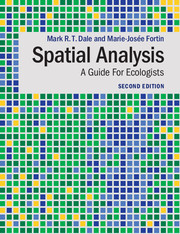Book contents
- Frontmatter
- Dedication
- Contents
- Preface
- 1 Spatial concepts and notions
- 2 Ecological and spatial processes
- 3 Points, lines and graphs
- 4 Spatial analysis of complete point location data
- 5 Contiguous units analysis
- 6 Spatial analysis of sample data
- 7 Spatial relationship and multiscale analysis
- 8 Spatial autocorrelation and inferential tests
- 9 Spatial partitioning: spatial clusters and boundary detection
- 10 Spatial diversity analysis
- 11 Spatio-temporal analysis
- 12 Closing comments and future directions
- References
- Index
7 - Spatial relationship and multiscale analysis
Published online by Cambridge University Press: 05 September 2014
- Frontmatter
- Dedication
- Contents
- Preface
- 1 Spatial concepts and notions
- 2 Ecological and spatial processes
- 3 Points, lines and graphs
- 4 Spatial analysis of complete point location data
- 5 Contiguous units analysis
- 6 Spatial analysis of sample data
- 7 Spatial relationship and multiscale analysis
- 8 Spatial autocorrelation and inferential tests
- 9 Spatial partitioning: spatial clusters and boundary detection
- 10 Spatial diversity analysis
- 11 Spatio-temporal analysis
- 12 Closing comments and future directions
- References
- Index
Summary
Introduction
To determine the factors and processes that are responsible for the spatial pattern observed in ecological data, both correlative methods (this Chapter) and inferential methods (mostly regression; Chapter 8) can be used. The ecological data of interest can be univariate (a single variable, such as species abundance or plant height, and so on) or multivariate (several variables, such as species composition or environmental variables, and so on). With multivariate data, as with univariate data, the first step is always to evaluate the variables’ spatial autocorrelation and to determine its significance. This can be achieved by using modified spatial autocorrelation coefficients or semi-variance functions for distance matrices based on the multivariate data, instead of equivalent measures for the original observations themselves (Wartenberg 1985; Wackernagel 2010; Dray et al. 2012; Legendre & Legendre 2012). Many current ecological studies are carried out over large study areas (risking non-stationarity) often combining several data types. Researchers need therefore to perform Exploratory Spatial Data Analysis (ESDA) to determine the key spatial scale(s) at which statistical analyses should be performed (Fortin et al. 2012a).
In this chapter, we present methods that quantify the spatial relationship between spatially autocorrelated variables (both univariate and multivariate) using correlation in the spatial context, and we then show how multiscale analysis can depict the spatial scales relevant to the spatial structure of the ecological data. In Chapter 8, which follows, we will summarize the key methods that are used to model spatial causality between spatially autocorrelated variables. The spatio-temporal analysis of such data will be covered in Chapter 11.
- Type
- Chapter
- Information
- Spatial AnalysisA Guide For Ecologists, pp. 182 - 205Publisher: Cambridge University PressPrint publication year: 2014



